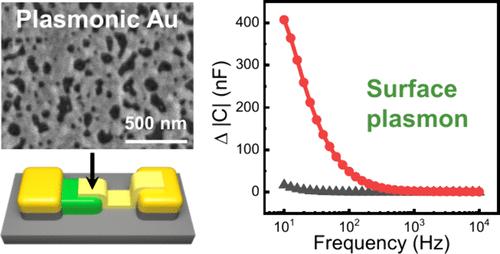Effects of Surface Plasmon and Catalytic Reactions on Capacitance in Metal–Semiconductor Schottky Diodes
IF 8.2
2区 材料科学
Q1 MATERIALS SCIENCE, MULTIDISCIPLINARY
引用次数: 0
Abstract
Capacitors, renowned for their high power and energy density attributed to their rapid discharge capabilities, hold significant promise as energy storage devices. While capacitors with various junctions have been the subject of extensive research, there remains a significant knowledge gap concerning the fundamental photoelectron dynamics within metal–semiconductor (MS) junction capacitance, which is crucial for the development of photodevices. Here, we demonstrate the effects of localized surface plasmon resonance (LSPR) on the capacitance behavior of Au/TiO2 Schottky diodes, one of the MS junction diode systems. We have confirmed that the plasmonic Au/TiO2 shows substantial photoresponsiveness, with an increase in net total capacitance under stronger plasmonic effects, as confirmed by wavelength- and power-dependent studies. To enhance our understanding of the electron transfer process occurring at the MS junction, we expand our investigation of capacitance within a catalytic reaction environment, specifically focusing on Pt/TiO2 Schottky diodes. We show the catalytic environment changes capacitance values of the Pt/TiO2, and more active catalytic reactions decrease net total capacitance due to catalytic electrons interfering with diffusion electrons. The LSPR effect and catalytic reaction significantly impact the net total capacitance with a predominant contribution associated with hot electrons, catalytic electrons, and diffusion effects. These findings provide valuable insights for designing and optimizing efficient optical and catalytic devices across diverse applications.

表面等离子体和催化反应对金属-半导体肖特基二极管电容的影响
电容器因其快速放电能力而以其高功率和能量密度而闻名,作为储能设备具有重要的前景。虽然具有各种结的电容器已经成为广泛研究的主题,但在金属半导体(MS)结电容的基本光电子动力学方面仍然存在显着的知识差距,这对光器件的发展至关重要。在这里,我们展示了局部表面等离子体共振(LSPR)对Au/TiO2肖特基二极管(MS结二极管系统之一)电容行为的影响。我们已经证实,等离子体Au/TiO2表现出实质性的光响应性,在更强的等离子体效应下,净总电容增加,正如波长和功率相关的研究所证实的那样。为了加强我们对发生在MS结的电子转移过程的理解,我们在催化反应环境中扩展了我们对电容的研究,特别关注Pt/TiO2肖特基二极管。我们发现,催化环境改变了Pt/TiO2的电容值,更活跃的催化反应由于催化电子干扰扩散电子而降低了净总电容。LSPR效应和催化反应对净总电容有显著影响,其中热电子、催化电子和扩散效应对净总电容的影响最大。这些发现为设计和优化各种应用中的高效光学和催化装置提供了有价值的见解。
本文章由计算机程序翻译,如有差异,请以英文原文为准。
求助全文
约1分钟内获得全文
求助全文
来源期刊

ACS Applied Materials & Interfaces
工程技术-材料科学:综合
CiteScore
16.00
自引率
6.30%
发文量
4978
审稿时长
1.8 months
期刊介绍:
ACS Applied Materials & Interfaces is a leading interdisciplinary journal that brings together chemists, engineers, physicists, and biologists to explore the development and utilization of newly-discovered materials and interfacial processes for specific applications. Our journal has experienced remarkable growth since its establishment in 2009, both in terms of the number of articles published and the impact of the research showcased. We are proud to foster a truly global community, with the majority of published articles originating from outside the United States, reflecting the rapid growth of applied research worldwide.
 求助内容:
求助内容: 应助结果提醒方式:
应助结果提醒方式:


